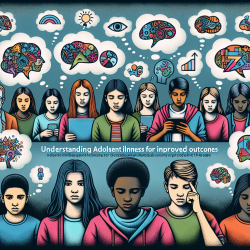Introduction
Youth homelessness is a critical issue that requires attention and action from practitioners across various fields, including speech-language pathology. The research article "Prevalence and Correlates of Youth Homelessness in the United States" provides valuable insights into the scale and characteristics of youth homelessness, which can inform practitioners in developing effective interventions and support systems.
Understanding the Data
The study utilized a nationally representative phone-based survey to gather data on youth homelessness, focusing on adolescents aged 13–17 and young adults aged 18–25. The findings revealed that approximately 4.3% of households with 13- to 17-year-olds and 12.5% of households with 18- to 25-year-olds experienced some form of homelessness, including couch surfing.
Key demographic groups identified as having a higher risk of homelessness include young parents, black, Hispanic, and LGBT youth, and those who did not complete high school. These insights highlight the need for targeted interventions that address the specific needs of these vulnerable populations.
Implications for Practitioners
For practitioners, particularly those in speech-language pathology and related fields, understanding the prevalence and characteristics of youth homelessness is crucial for developing effective support strategies. Here are some actionable steps practitioners can take:
- Collaborate with Schools and Community Organizations: Partner with schools and community organizations to identify at-risk youth and provide tailored support services, including speech and language therapy.
- Advocate for Policy Changes: Use data-driven insights to advocate for policy changes that address the root causes of youth homelessness and provide resources for prevention and intervention programs.
- Develop Inclusive Programs: Create inclusive programs that cater to the diverse needs of homeless youth, considering factors such as cultural background, sexual orientation, and educational attainment.
- Engage in Continuous Research: Encourage ongoing research to monitor trends in youth homelessness and evaluate the effectiveness of interventions, ensuring that programs remain relevant and impactful.
Conclusion
The research on youth homelessness underscores the importance of data-driven decision-making in developing effective interventions. Practitioners can play a pivotal role in addressing this issue by leveraging data to inform their practices and advocating for systemic changes. By working collaboratively with other stakeholders, practitioners can help create a supportive environment that fosters positive outcomes for homeless youth.
To read the original research paper, please follow this link: Prevalence and Correlates of Youth Homelessness in the United States.










